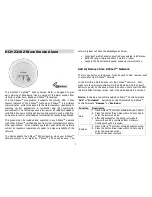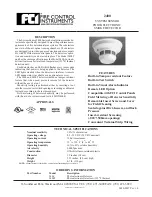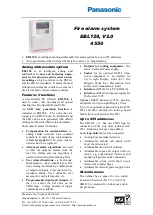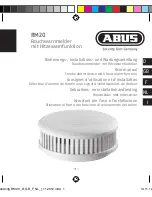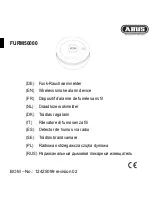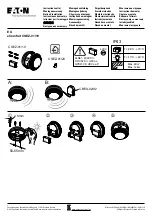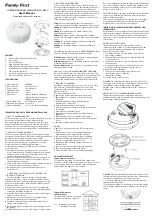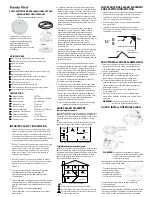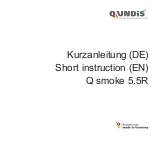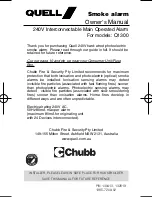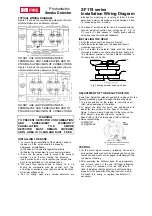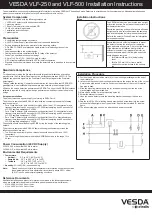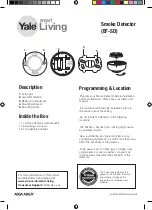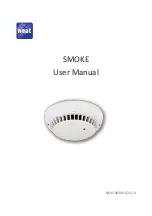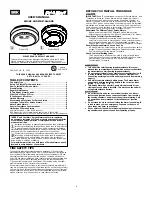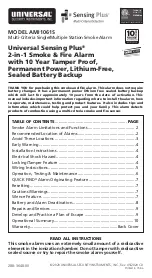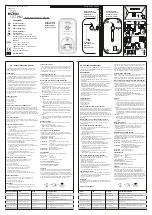
P/N 3102145 (ML) • REV F • ISS 11MAR19
7 / 25
•
CO being present on one level of the home and not
reaching a CO alarm installed on a different level. (For
example, CO in the basement may not reach an alarm on
the second level, near the bedrooms).
For these reasons, we recommend you provide complete
coverage by placing a CO alarm on every level of the home.
CO alarms should not be used to detect the presence of
natural gas (methane), propane, butane, or other combustible
fuels.
Instruct children never to touch or otherwise interfere with the
alarm. Warn children of the dangers of CO poisoning.
Toxic effects
Carbon monoxide (CO) is a colourless, odourless, non-irritating
gas classified as a chemical asphyxiant and whose toxic action
is a direct result of the hypoxia produced by a given exposure.
CO is rapidly absorbed through the lungs, diffuses across the
alveolar capillary membrane and is reversibly bound with
haemoglobin as carboxyhaemoglobin (COHb), however, a
minute amount is present in the plasma.The affinity of
haemoglobin for CO is over 200 times its affinity for oxygen.
This reduces the oxygen carrying capacity of the blood, and
has an effect on the dissociation of oxyhaemoglobin, which
further reduces the oxygen supply to the tissues. CO is
chemically unchanged in the body, and is eliminated in expired
air. The elimination is determined by the same factors that
applied during absorption. The half-life while breathing room air
is 2 h
– 6.5 h depending on the initial COHb level [1].
If the CO level in the inhaled air is constant, the level of COHb
in the blood will approach an equilibrium (saturation) state after
several hours. However, the rate at which the equilibrium is
reached depends on many factors, e.g. lung ventilation rate
(physical activity) and alveolar capillary transfer, cardiac
parameters, blood haemoglobin concentration, barometric
pressure, oxygen and carbon dioxide concentration in the
inhaled air,but the two most important factors in determining
the COHb level are the CO concentration and the duration of
exposure.
The effects of different saturation blood COHb levels on
healthy adults are shown in Table 1 below.
Table 1: Health effects of COHb blood levels on healthy adults
Parts per
million (ppm)
Effects on adults
100
Slight headache, nausea, fatigue (flu-like
symptoms)
200
Dizziness and headache within 2
–3 hours
400
Nausea, frontal headache, drowsiness, confusion
and rapid heart rate. Risk to life after over 3 hours
of exposure.
800
Severe headache, convulsions, vital organ failure.
Death possible within 2
–3 hours.
The relationship between the CO concentration and the
duration of exposure can be calculated for a given %COHb, by
parameterising the above factors. Figure 8 below shows
examples for a person undertaking light/moderate exercise.
Figure 8
Chronic effects on high risk groups:
Individuals with
coronary artery disease exposed to low levels of CO show
reduced ability to exercise and the time of onset of exercise-
induced angina pectoris in such patients exposed to low levels
of CO is reduced. Carbon monoxide readily crosses the
placental barrier and may endanger the normal development of
the foetus. A number of high-risk groups are particularly
sensitive to the effects of CO because of various organ
impairments or specific changes [1], mainly:
a) those whose oxygen carrying capacity is decreased due to
anaemia or other haemoglobin disorders;
b) those with increased oxygen needs such as those
encountered in fever, hyperthyroidism or pregnancy;
c) those with systemic hypoxia due to respiratory insufficiency;
d) those with heart disease and any vascular insufficiency.
WHO guidance [1] states that in order to protect non-smoking,
middle-aged and elderly population groups with documented or
latent coronary artery disease from acute ischaemic heart
attacks, and to protect the fetuses of non-smoking pregnant
women from untoward hypoxic effects, a COHb level of 2.5%
should not be exceeded. The following WHO guideline values
and periods of time-weighted average exposures have been
determined in such a way that the COHb level of 2.5% is not
exceeded, even when a normal subject engages in light or
moderate exercise:
•
100 mg/m
³ (90 ppm) for 15 min;
•
60 mg/m³ (50 ppm) for 30 min;
•
30 mg/m³ (25 ppm) for 1 h;
•
10 mg/m³ (10 ppm) for 8 h.
Normal COHb levels:
Under normal conditions, humans
typically have low levels of COHb of between 0.3% and 0.7%
present within the body. These levels are considered neither
beneficial nor harmful.
Tobacco smoking:
Tobacco smokers are exposed to
significant concentrations of CO. In cigarette smokers, the
COHb concentration varies between 5%
–9%, while heavy
cigar smokers may exceed 10%.
Bibliography
[1] Air quality guidelines, Second Ed. Chapter 5.5 Carbon
monoxide. WHO Regional Office for Europe, Copenhagen, DK.
2000.























